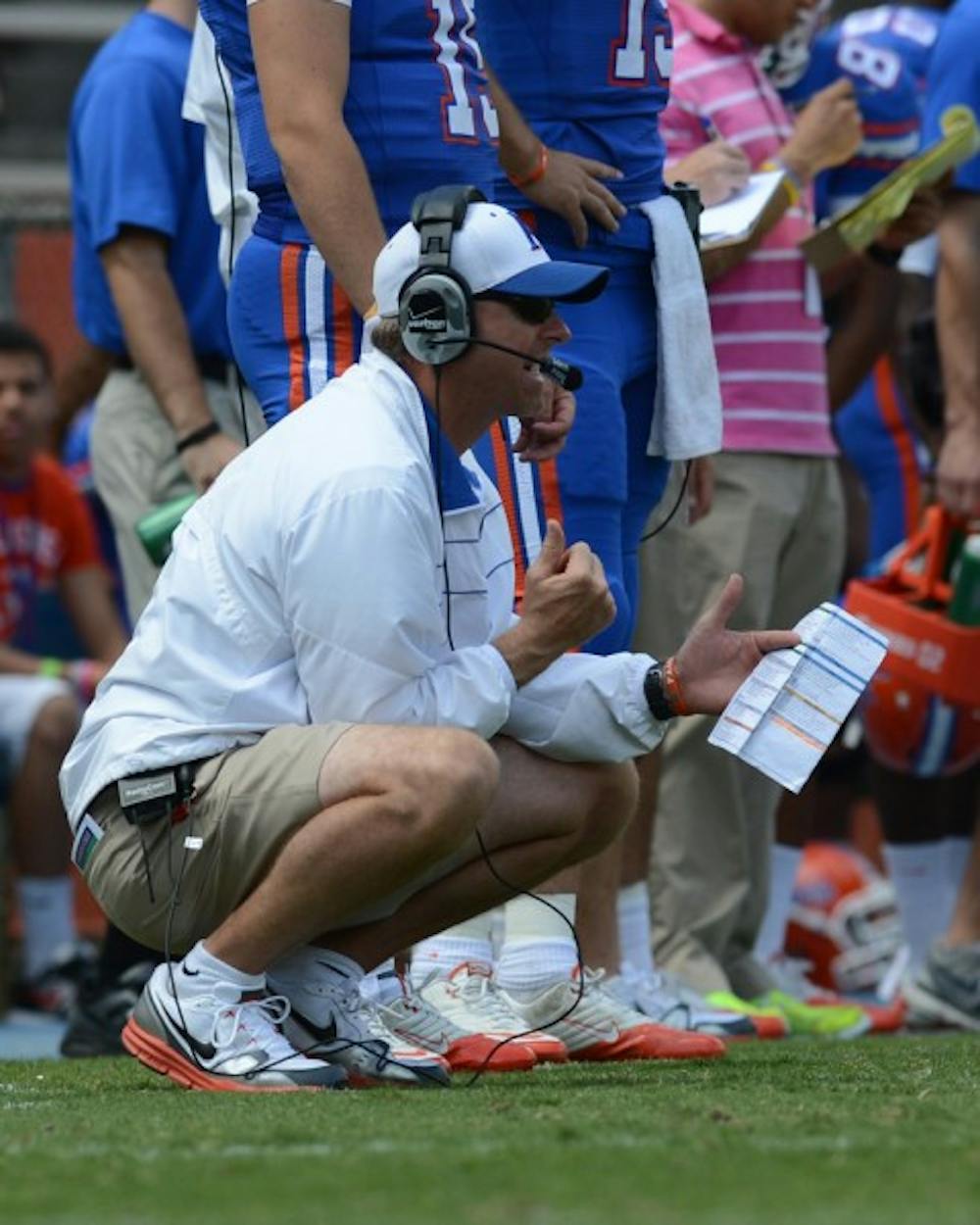Calling 20 power runs in a game seems like an easy and monotonous task.
Quarterback takes snap, guard pulls, quarterback hands to running back, success. Simple.
But not the way UF offensive coordinator Brent Pease does it.
Even when Pease calls a run-heavy offense, as he did when he dialed up 25 consecutive running plays to close out Florida’s upset of LSU, his play-calling is practically a work of art.
The number of different formations, motions, sweep actions and personnel groupings Pease employs are enough to make defensive coordinators’ heads spin, even if UF is essentially running the same play nearly 30 times per game.
So while it’s easy to credit Gillislee and the offensive line for gaining 176 yards on the ground against the Tigers, don’t forget about the man upstairs moving all the chess pieces.
On Tuesday, Pease said flexibility and creativity in the run game have been key to UF’s success. He wasn’t kidding.
Even neglecting pre-snap motion, UF ran the ball in more than a dozen different personnel groupings. From Driskel’s quarterback blast in a five-wide set, to Driskel’s keeper on a rollout with one back and four tight ends. The Gators also ran 16 plays with multiple players lined up in both back and tight end positions.
The task of trying to defend the ground game gets even more difficult when Florida starts lining up tackles in the tight-end spots.
By my unofficial count, reserve linemen D.J. Humphries and Ian Silberman were both on the field for 10 plays. Humphries was in without Silberman for another three. Humphries, Silberman and the five starters on the offensive line weigh a combined 2,146 pounds.
Pease said the choice to play that group comes down to the theory that “mass kicks ass,” but it isn’t that simple.
The Gators’ offensive coordinator makes those players more effective by putting that mass in motion. Florida pulled a guard on 24 of its 53 rushing attempts — counting sacks as pass attempts — against LSU. The Gators put both a guard and tackle in motion on another four, including Gillislee’s 12-yard touchdown run in the third quarter that gave Florida a 7-6 lead.
That call in particular was a thing of beauty.
In the first quarter, the Gators lined up with two backs about 4 yards behind the line of scrimmage and offset to Driskel’s left.
At the snap, left tackle Xavier Nixon and left guard James Wilson pulled to block right. Solomon Patton sprinted across the formation from his position on the right flank to snatch a handoff from Driskel and run left on the sweep.
The play went for a loss of 2 yards. That alignment wasn’t seen again until Gillislee’s touchdown run. Everything happened the same as it did in the first quarter, and the defense again reacted to Patton’s sweep action.
Only this time Driskel handed to Gillislee, who followed Nixon and Wilson through a gaping hole and into the end zone untouched.
For as much of a smash-mouth style as Florida’s is, Pease compliments it with this type of deception. Instead of lining Patton up at wide receiver and running a traditional jet sweep, Pease twice lined Patton up at tight end to hide the reverse action from LSU’s defense.
Pease’s background makes his success orchestrating Florida’s running game even more impressive.
Counting sacks as pass attempts instead of rush attempts, the Gators have run the ball on 65.8 percent of plays this season. With Boise State in 2011, Pease’s attack was astonishingly balanced: 485 pass attempts, 484 rush attempts.
Pease said he knew when he was hired at Florida that coach Will Muschamp wanted a run-heavy attack, and obviously Muschamp figured Pease would be up to the task.
Still, Pease’s ability to direct successful offenses under vastly different philosophies says a great deal about his talent as a play caller, even if Gillislee and the offensive linemen are the ones doing all the heavy lifting.
Contact Greg Luca at gluca@alligator.org.
Gators offensive coordinator Brent Pease watches the action during Florida's spring game on last April at Ben Hill Griffin Stadium. Although UF has run the ball 65.8 percent of the time this season, Pease has brought creativity to the offense from his previous job as offensive coordinator at Boise State.






